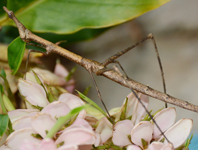Abstract
The population of Mobula birostris (“giant manta ray”) found in the waters of northern Peru and Ecuador is believed to be the largest in the world (Harding & Beirwagen, 2009). This species is considered to be the largest within the group of manta rays, as they attains at least 670 cm disc width (reported to 910 cm) (White et al., 2006) and there is a record of an individual weighing 2000 kg (Kunjipalu & Boopendranath, 1981). This species is ovoviviparous (matrotrophic viviparious) (Herbert, 2012). A single pup follows a gestation period of approximently one year, (Marshall et al., 2008, Mendonça et al., 2012). Sucessive pregnancies are speculated to be separated by a refactory period of two or more years (Mendonça et al., 2012). The objective of this study is to record the measurements of a M. birostris fetus of a female caught accidentally in the region of Tumbes, Peru. This is the first record of morphological and morphometric data regarding a manta fetus in Peru.
References
Beebe, W. & Tee-Van, J. (1941) Eastern Pacific expeditions of the New York Zoological Society. XXVIII Fishes from the tropical eastern pacific. Part 3: Rays, Mantas, and Chimaeras. Zoologica: Scientific Contributions of the New York Zoological Society, 26, 245–280.
Casas, A., Cunha, C., Intelizano, W. & González, M. (2006) Record of a pregnant bentfin devilray, Mobula thurstoni (Lloyd) (Elasmobranchii, Mobulidae) caught in Southwestern Brazil. Pan-American Journal of Aquatic Sciences, 1 (1), 66–68.
Dewar, H., Mous, P., Domeier, M., Muljadi, A., Pet, J. & Whitty, J. (2008) Movements and site fidelity of the giant manta ray, Manta birostris, in the Komodo Marine Park, Indonesia. Marine Biology, 155 (2), 121–133.
https://doi.org/10.1007/s00227-008-0988-x
Fiedler, P.C., Philbrick, V. & Chavez, F.P. (1991) Oceanic Upwelling and Productivity in the Eastern Tropical Pacific. Limnology and Oceanography, 36 (8), 1834–1850.
https://doi.org/10.4319/lo.1991.36.8.1834
Harding, M. & Beirwagen, S. (2009) Population research of Manta birostris in coastal waters surrounding Isla de la Plata, Ecuador. Unpublished report. [pagination unkown]
Herbert, J. (2012). Manta birostris (Manta Ray Giant). The Online Guide to the Animals of Trinidad and Tobago. Department of Life Sciences. The University of the West Indies, St Augustine. Available from: https://sta.uwi.edu/fst/lifesciences/sites/default/files/lifesciences/documents/ogatt/Manta_birostris%20-%20Giant%20Manta%20Ray.pdf (accessed 10 November 2017)
Kunjipali, K.K. & Boopendranath, M.R. (1981) Note on the Catch of a Giant Ray Manta birostris (Walbaum) off Veraval, North West Coast of India. Indian Journal of Fisheries, 28 (1 & 2), 278–280.
Marshall, A.D., Pierce, S.J. & Bennett, M.B. (2008) Morphological measurements of manta rays (Manta birostris) with a description of a foetus from the east coast of Southern Africa. Zootaxa, 1717, 24–30.
Marshall, A., Compagno, L. & Bennett, M. (2009) Redescription of the genus Manta with resurrection of Manta alfredi (Krefft, 1868) (Chondrichthyes; Myliobatoidei; Mobulidae). Zootaxa, 2301, 1–28.
Mendonça, S.A., Macena, B.C.L., Creio, E., Viana, D.L., Viana, D.F. & Hazin, F.H.V. (2012) Record of a pregnant Mobula thurstoni and occurence of Manta birostris (Myliobatiformes: Mobulidae) in the vicinity of Saint Peter and Saint Paul Archipelago (Equatorial Atlantic). Pan-American Journal of Aquatic Sciences, 7 (1), 21–26.
Tomita, T., Toda, M., Ueda, K., Uchida, S. & Nakaya, K. (2012) Live-bearing manta ray: how the embryo acquires oxygen without placenta and umbilical cord. Biology Letters, 8 (5), 721–724.
https://doi.org/10.1098/rsbl.2012.0288
White, W.T., Last, P.R., Stevens, J.D., Yearsley, G.K., Fahmi & Dharmadi, D. (2006) Economically important sharks and rays of Indonesia. [Hiu dan pari yang bernilai ekonomis penting di Indonesia]. ACIAR Publishing, Canberra, 329 pp.

